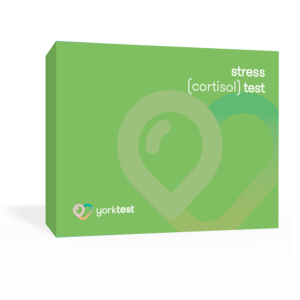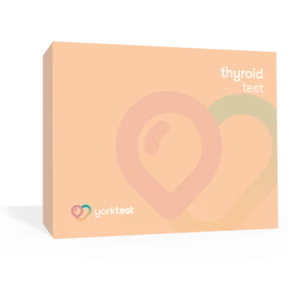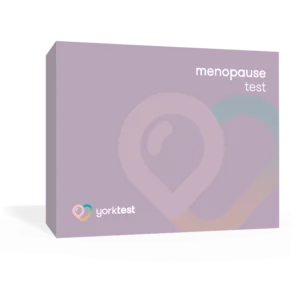- What is FODMAP?
- Why are FODMAPs difficult to digest?
- Are FODMAPs bad for everyone?
- What is a low FODMAP diet?
- What are the benefits of a low FODMAP diet?
- How does the low FODMAP diet work?
- How to follow a low FODMAP diet?
- What should I do before starting the low FODMAP diet?
- What can I eat on the FODMAP diet?
- Which high FODMAP foods are the best to avoid?
- Take the guesswork out with a Food Intolerance Test
You might have seen the phrase ‘low FODMAP diet’ popping up a lot recently. In 2022 and 2023 there has been a spike in Google searches for this term. Plus, there are 100,000’s of Instagram posts about #LowFODMAPDiet and #LowFODMAPRecipies.
So, it’s definitely a popular diet, but how do you know whether a low FODMAP diet might be right for you? In this article, we break down what FODMAP means, the potential benefits of a low FODMAP diet and the foods you can eat (and what’s best to avoid!) when following a low FODMAP diet.
What is FODMAP?
FODMAP is an acronym that stands for “Fermentable Oligosaccharides, Disaccharides, Monosaccharides, and Polyols.” These are short-chain carbohydrates that are found in many common foods, and they can be poorly absorbed by the gut, where they can then stagnate in gut bacteria. Your gut bacteria will then use these small chains as fuel and produce hydrogen gas, causing bloating, flatulence, and other digestive symptoms.
Why are FODMAPs difficult to digest?
FODMAPs are difficult to digest because they are short-chain carbohydrates that are not completely absorbed by the gut. This means that they pass through the small intestine and enter the large intestine, where they can draw water into the gut and ferment. This fermentation process can cause a range of digestive symptoms, including bloating, gas, abdominal pain, and diarrhea. Additionally, some people may have difficulty digesting FODMAPs because they have a sensitivity to these carbohydrates or because they have a condition that affects their ability to absorb them properly.
Are FODMAPs bad for everyone?
FODMAPs are not necessarily bad for everyone. In fact, most people can tolerate FODMAPs without any problems.
What is a low FODMAP diet?
A low FODMAP diet is a dietary approach that is used to manage symptoms of irritable bowel syndrome (IBS) and other digestive disorders. Consuming a low FODMAP diet involves avoiding foods that are high in these small chain carbohydrates, which can help to reduce symptoms like bloating, gas, abdominal pain, and diarrhea. This approach is often recommended by doctors and dietitians as a way to manage digestive symptoms, but it should be followed under the guidance of a healthcare provider.


What are the benefits of a low FODMAP diet?
A low FODMAP diet can be beneficial for people with digestive disorders, such as irritable bowel syndrome (IBS). The diet involves limiting foods that are high in certain types of carbohydrates called FODMAPs, which can be difficult for some people to digest. By reducing the intake of these foods, the diet can help reduce symptoms such as bloating, abdominal pain, and diarrhea.
How does the low FODMAP diet work?
The low FODMAP diet typically involves a phased approach, where foods that are high in FODMAPs are gradually eliminated and then gradually reintroduced, with the goal of identifying which foods are well-tolerated and which are not. This approach can help to identify specific foods that may be triggering digestive symptoms, and it can also help to ensure that the diet is nutritionally balanced.
How to follow a low FODMAP diet?
A low FODMAP diet involves three strict stages and it is best to undertake this diet only after consultation with a healthcare professional:
Stage 1: Restriction
This stage involves strict avoidance of all high-FODMAP foods, for a period of 4-8 weeks. This period of food avoidance will allow the gut to heal. Some people notice improvements in symptoms within the first week. However, it may take longer. Up to 75% of people following the low FODMAP diet reported improved symptoms within 6 weeks.
Stage 2: Reintroduction
This stage involves reintroducing small amounts of high-FODMAP foods one by one for 3 days then waiting 2-3 days.
This stage can take up to 10 weeks and allows the identification of:
- which types of FODMAPs you are sensitive to or tolerate.
- the amount of FODMAPs you can tolerate, i.e., your threshold/tolerance level.
It is important to remember that unlike allergies, where the food causing the allergy must be avoided, people who are sensitive to FODMAPs can tolerate small amounts after their gut has healed.
Stage 3: Personalisation
During this stage, the amount and type of FODMAPs you can tolerate, identified in stage 2, are incorporated into a tailored diet. You may still be required to restrict certain foods. There is no one-size-fits-all diet, and the ultimate goal is to reintroduce high-FODMAP foods to your tolerance level.
What should I do before starting the low FODMAP diet?
If you suffer with digestive symptoms and think that you may have IBS, it is important that you consult your health practitioner, to rule out any chronic conditions (celiac disease, inflammatory bowel disease, colon cancer and defecatory disorders).
Before starting a low FODMAP diet it is important to have:
- Confirmed that you have IBS. You must fulfill 3 criteria:
- Recurrent stomach pain (at least 1 day per week in the last 3 months)
- Stool symptoms (related to defecation, associated with a change in stool frequency, or associated with a change in the appearance of stool)
- Persistent symptoms (for at least 3 months with symptom onset at least past 6 months before diagnosis)
- Tried lifestyle and dietary changes, such as:
- Regular physical exercise
- Minimising stress
- Cutting back on caffeinated beverages
- Eating smaller meals, and avoiding deep-fried or spicy foods
- Planned ahead, as following a low FODMAP diet can be challenging:
- Find out what to buy and making a shopping list.
- Get rid of any high-FODMAP foods in your fridge or pantry.
- Read menus in advance when going out to eat.
What can I eat on the FODMAP diet?
There is a wide variety of healthy foods that you can eat on a low FODMAP diet, including:
- proteins: meats (beef, chicken, lamb, pork), fish, prawns, tempeh, tofu, and eggs
- all fats and oils
- most herbs and spices
- nuts and seeds (including peanuts, almonds, macadamia nuts, pine nuts, and sesame seeds but not pistachios or cashews, which are high in FODMAPs)
- fruits, such as: unripe bananas, blueberries, cantaloupe, grapefruit, grapes, kiwi, lemons, lime, mandarins, melons (except watermelon), oranges, passionfruit, raspberries, strawberries
- sweeteners (maple syrup, molasses, and stevia)
- dairy products: lactose-free milk, Greek yogurt, and Mozzarella, Cheddar, Colby and Parmesan cheeses.
- vegetables, such as: alfalfa, bell peppers, Bok choy, carrots, celery, chives, cucumbers, eggplant, ginger, green beans, kale, lettuce, olives, parsnips, potatoes, radishes, spinach, spring onion (only green), squash, sweet potatoes, tomatoes, turnips, water chestnuts, yams, zucchini
- grains and starches: corn, oats, quinoa, rice, sorghum, tapioca, cassava, lentils, potatoes
- beverages (water, tea, coffee, etc.)
These lists are neither definitive nor exhaustive and it is important to remember that everyone is different. You may tolerate some foods on the list of foods to avoid while noticing digestive symptoms from foods low in FODMAPs for other reasons.
Which high FODMAP foods are the best to avoid?
FODMAPs can be found in a range of foods, for example:
- Oligosaccharides:wheat, rye, nuts, legumes, artichokes, garlic, and onion
- Disaccharides:lactose-containing products such as milk, yogurt, soft cheese, ice cream, buttermilk, condensed milk, and whipped cream
- Monosaccharides:fructose-containing foods, including fruits such as apples, pears, watermelon, and mango and sweeteners such as honey, agave nectar, and high fructose corn syrup
- Polyols:mannitol and sorbitol in apples, pears, cauliflower, stone fruits, mushrooms, and snow peas, as well as xylitol and isomalt in low calorie sweeteners, such as those in sugar-free gum and mints.
Take the guesswork out with a Food Intolerance Test
If like Devan, you are struggling with IBS symptoms, in addition to a FODMAP elimination diet, which can be discussed with one of our experienced Nutritional Therapists, our Premium Food Intolerance Test can help you to identify which foods may be the cause.
At YorkTest, our Premium Food Intolerance Test is one of the most comprehensive ways to determine whether you have a sensitivity to over 200 food and drink ingredients. It’s an at-home finger-prick test that measures all four subtypes of food-specific IgG which comes with easy-to-read results broken down by high, borderline, and normal reactivity.
YorkTest have 40 years of experience in helping people identify their intolerances. Learn more about the Premium Food Intolerance Test, which is backed by expert analysis from our fully accredited laboratory technicians.













